Author: Biteye Core Contributor Louis Wang
Editor: Biteye Core Contributor Crush
Community: @BiteyeCN
In September 2021, ERC4337 was officially proposed as a standard for account abstraction, aiming to improve the account experience in the Ethereum ecosystem through smart contracts.
- NFT quietly integrates into the mainstream ‘Fat Penguin’ settles in Walmart, Microsoft Xbox may integrate encrypted wallet.
- Practical Exploration and Case Analysis of AI+Blockchain Games
- Cosmos&Polkadot V.S. Layer2 Stacks Chapter 3 From Layer 2 Networks to Super Chains
By doing so, there is no need to modify the Ethereum consensus layer, making it easier to implement, and any potential increase in gas consumption will be greatly reduced with the development of layer 2 solutions and the launch of future upgrades.
February 28th of this year was an important milestone for ERC4337, as the entry point contract (EntryPoint) was deployed to the Ethereum mainnet, and has since been expanded to over 20 EVM-compatible blockchains.
Since its launch six months ago, an increasing number of users, infrastructure, and dApps have started building their own on-chain applications based on this entry point contract. So how have the user metrics, infrastructure builders, and dApps performed?
Let’s explore the performance of ERC4337 since its launch by analyzing the data of the entry point contract.
01. Introduction to ERC4337
The Ethereum account system can be simply divided into EOA (Externally Owned Account) and CA (Contract Account). EOA is the native account type in Ethereum used to trigger Ethereum transactions;
CA, on the other hand, is essentially a smart contract, which provides good flexibility and programmability, leading to a better user experience. However, it cannot directly initiate Ethereum transactions, and when using CA, it still cannot avoid the issues caused by EOA, such as private key risks.
In the ERC4337 account abstraction standard, users have complete control over their CA and can use any desired verification method. The task of initiating Ethereum transactions will be executed by the Bundler.
The simple process is as follows:
1. Users use CA to initiate UserOperation (UserOp), a new type of transaction proposed by ERC4337, and send it to a dedicated UserOp mempool.
2. The Bundler will package the UserOp in a transaction in this mempool and initiate a transaction to the entry point contract using their EOA account. Since it is a transaction initiated by the Bundler, they will also pay for the gas.
3. The entry point contract is used to standardize transaction execution and prevent malicious transactions from affecting the Bundler. All Bundlers need to call it to execute UserOp.
4. Users need to pre-deposit gas in the entry point contract to pay the Bundler, or LianGuaiymaster can pay the gas on behalf of the user. LianGuaiymaster can be any third party willing to pay for the gas.
5. If the user has not created a contract wallet, the wallet factory contract will automatically create a smart contract wallet for the user.
02. User Analysis
User Growth
Currently, there are over 680,000 account abstraction wallets based on the ERC4337 standard that have been created, and a total of over 2 million UserOps have been initiated.
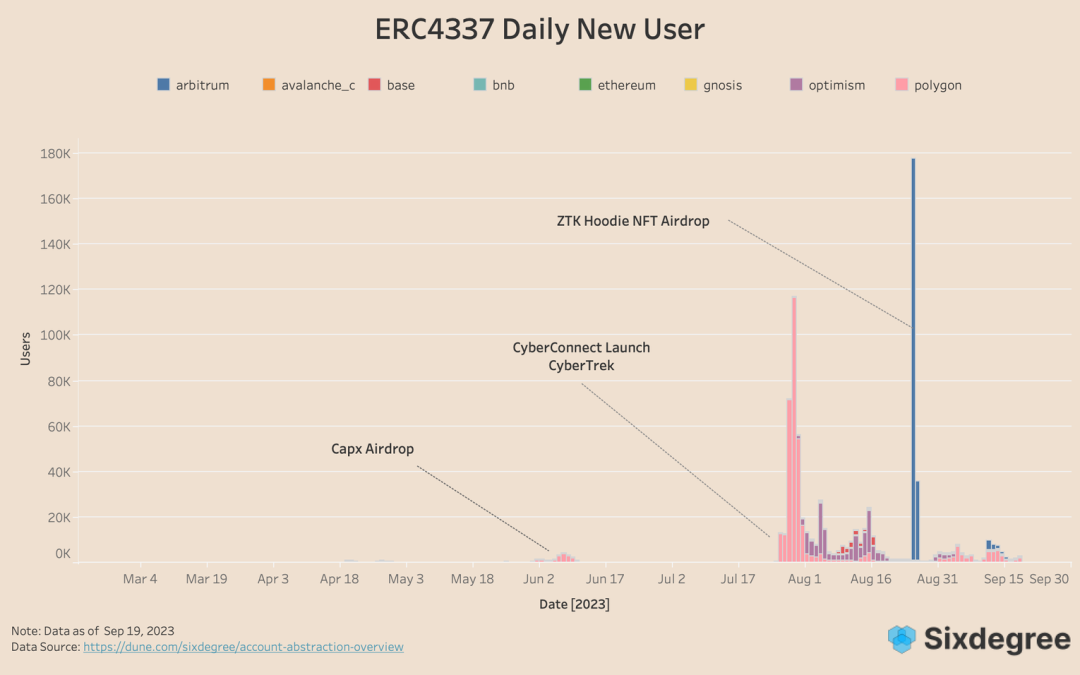
From the above figure, we can see that the number of users of AA has experienced three main growth phases:
The first growth phase was brought by the project The Capx App, which is a learn-to-earn app. By utilizing the advantages of AA’s packaging operations for token transfers, the platform has developed rapidly and has built an app chain based on zk-rollup technology using Polygon’s SDK.
The second growth phase came from CyberConnect’s Cyber Trek campaign, which incentivized users to create Cyber Accounts based on AA.
The third growth phase is the metaverse project ZepetoX (ZTX) on Arbitrum. Zepeto is a virtual fashion social platform for creating personal digital avatars, launched by the Korean internet giant Naver (the parent company of the social app LINE) in August 2018. ZTX is their new project extended to Web3.
User Activity

The growth of UserOp basically follows the curve of user growth, with the only difference being that UserOp has four growth phases, as the CyberConnect airdrop was distributed on the Optimism mainnet and users needed to claim it using the AA wallet.
Due to the fact that using ERC4337-based account abstractions will invoke more contracts and cause additional gas burden, most UserOp transactions occur on Layer2 chains with lower gas costs.
Polygon, Arbitrum, and Optimism account for the majority, with percentages of 48.89%, 27.25%, and 20.05%, respectively.
The art creation and trading platform Zeroone on Avalanche was launched on August 18, bringing over 40,000 UserOp transactions. The Base chain saw only a small amount of growth due to the recent Onchain Summer event.
Overall, the user activity is gradually increasing.
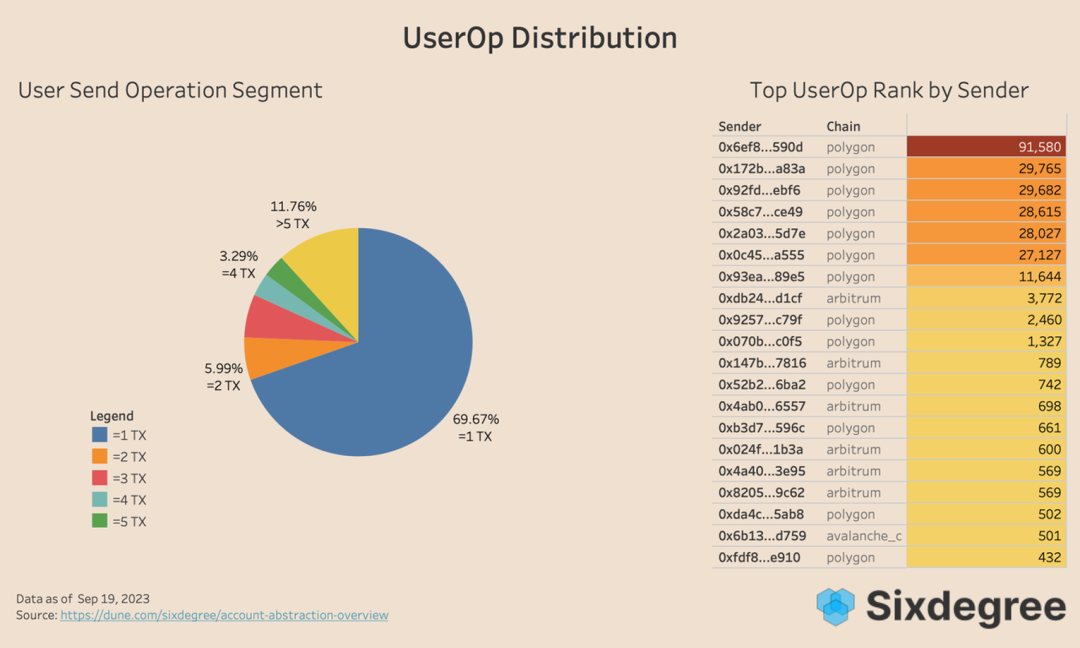
Looking specifically at the activity of each AA wallet, 88.24% of wallets have been used five times or less. Combining this with the user growth and UserOp growth charts above, it can be seen that most AA wallet users are a wave of users brought in by projects, indicating that there are not many additional applications beyond the designated operations of the projects.
There are two main reasons for this:
First, most 4337AA wallets are in-app wallets built by the project teams themselves;
Second, because most mainstream projects have not yet integrated with AA. Therefore, there is no situation where users use CyberWallet to claim ZTX commemorative NFTs, which means that user behavior is limited to these apps.
There are also a small number of AA wallets with particularly high usage frequencies, even reaching thousands or tens of thousands of times. For example, wallet 0x93 has initiated UserOp transactions more than 11,000 times, which is used by Capx for token distribution. Therefore, only a few project teams have use cases and truly leverage the advantages of AA wallets.
User Behavior
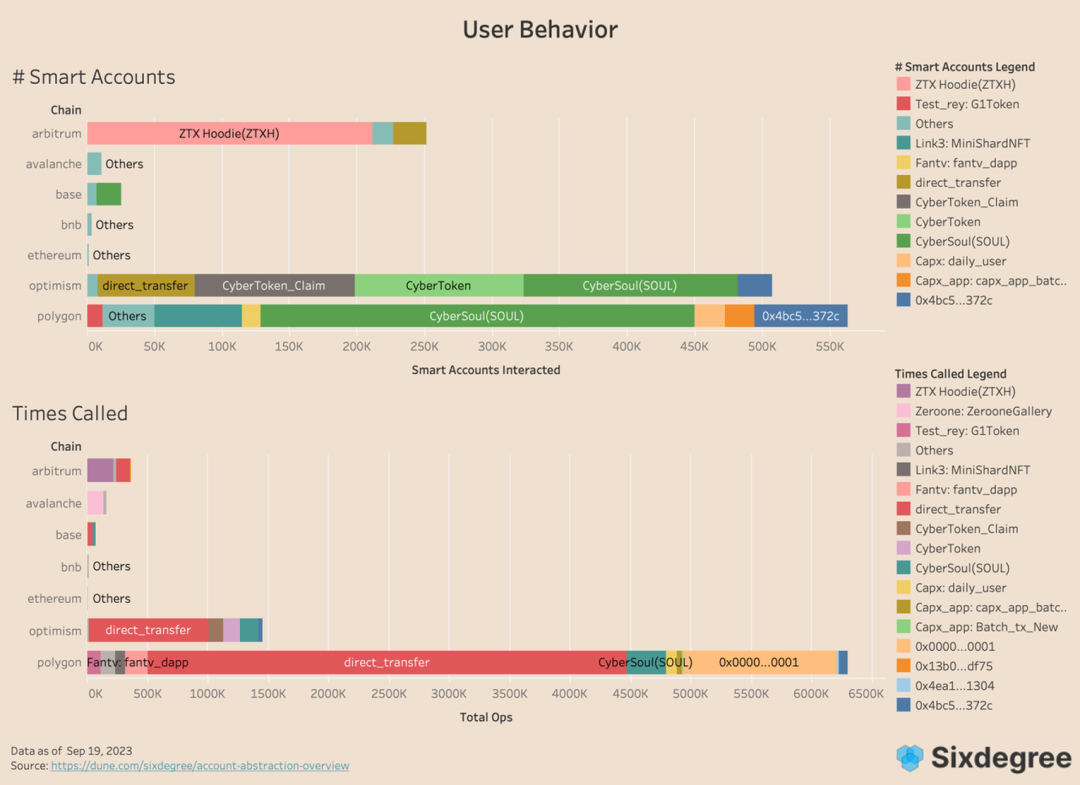
Focusing on the scenario where users use the AA wallet on the chain, Polygon has the richest variety of interactive contracts.
CyberConnect and ZTX are the main interactive contracts of the AA wallet. According to the number of contract calls, the majority of behaviors are mainly direct transfers and NFT minting, accounting for 90% of all user operations.
Take Polygon as an example, it can be found that direct transfers are only a small part of user interaction behaviors, but they have the highest frequency of use, which also confirms that only a small number of people have truly found suitable AA usage scenarios.
03, AA Infrastructure
Currently, AA wallets that adopt ERC4337 are mostly built in Lego mode, that is, different third-party modules are used to build their own AA wallets in applications. The advantage is convenience and easy implementation, but the disadvantage is lack of universality. The market situation and main participants of each module will be analyzed later.
Bundler
Bundler triggers transactions using EOA, freeing users from the hassle of EOA. It has strong public goods attributes and is a module with expected wealth effects.
Bundler’s income comes from two parts. First, the gas difference, which is the difference between the maximum priority gas fee and the actual gas expenditure. At the same time, it spreads the fixed gas expenditure to multiple users and obtains profits from these frictions;
Second, potential MEV income. Bundler’s role is very similar to that of block builders. When it discovers that a user’s UserOp includes MEV profits, bundler can also join in and capture a portion of this income.
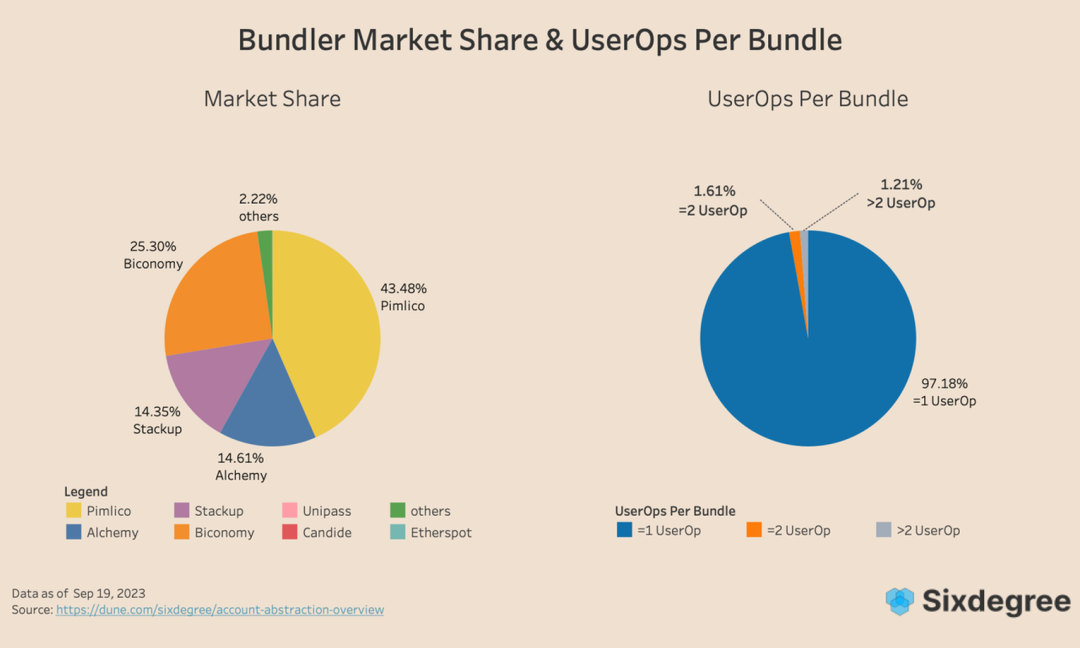
Currently, there are about 1.5k bundlers in total. Pimlico, Alchemy, Biconomy, and Stackup are the most mainstream players. These four companies account for over 97% of the bundler market.
Among them, Pimlico occupies 43.48% of the market share by extensively cooperating with various dApps and packaging the most UserOps.

Bundlers can package multiple UserOps into one transaction, but in reality, 97.18% of transactions only contain one UserOp.
This means that there are currently not enough UserOps, resulting in bundlers being completely underutilized, which further leads to almost no profit space for bundlers.
Currently, all bundlers generate about $38k in profits, with 88.38% in a break-even state. Among them, Alchemy ranks first with a profit of $20k, while Stackup and Pimlico rank second and third with profits of $11k and $5.8k, respectively.
LianGuaiymaster
LianGuaiymaster, as an option in the ERC4337 standard, actually pays for 96% of the gas for UserOps. This indicates that the majority of users using dApps have enabled this feature, creating a gasless experience for users.
Currently, 117 LianGuaiymaster have collectively paid $465k in gas fees, with Stackup, Pimlico, Alchemy, and Biconomy still occupying the majority.
Among them, Pimlico has paid the most for UserOps, accounting for 43.45% of the total, with a total payment of $144,000.
Next, Stackup accounts for 14.5%, while Alchemy and Biconomy account for approximately 16.43% and 23.29% respectively.
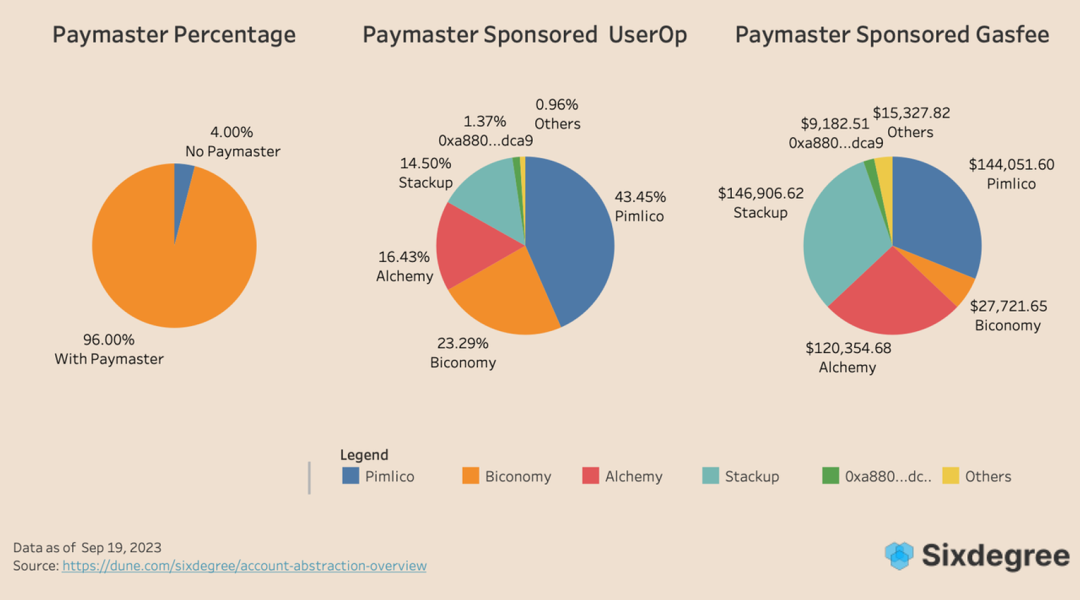
One notable point is that Pimlico’s average Gasfee paid for LianGuaiymaster UserOps is significantly lower than Stackup and Alchemy, which leads to a similar total gasfee despite the double number of UserOps paid.
The reason for the difference may be that different UserOps call different contracts. Pimlico has paid for a large number of dApp applications and direct transfers, many of which are low gas-consuming operations, resulting in the aforementioned difference in gas fees.
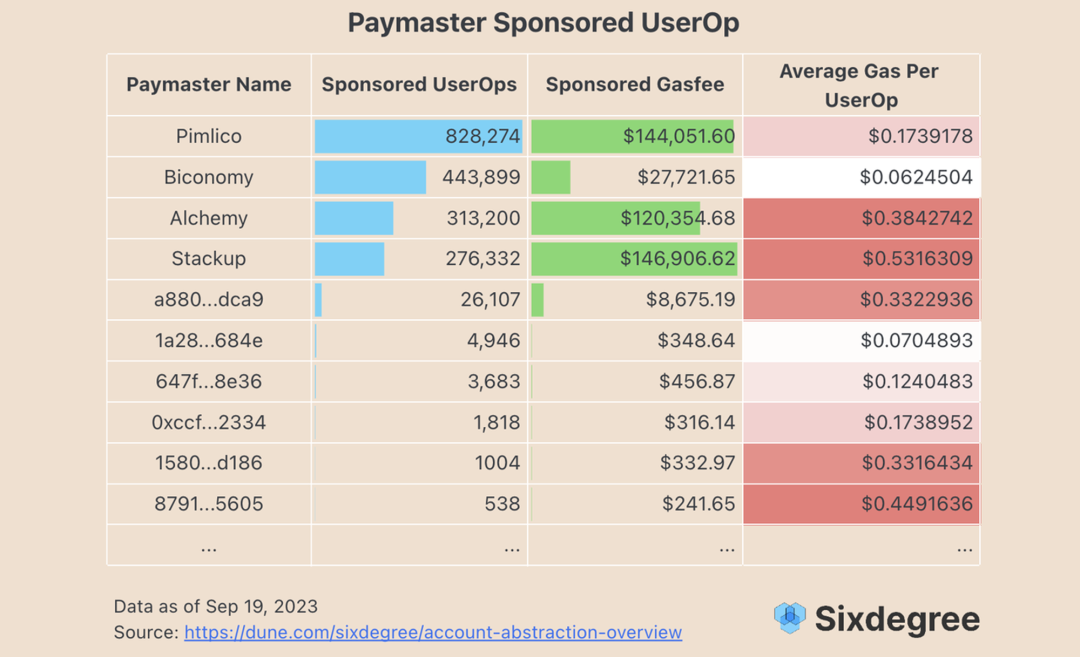
Wallet Factory
In terms of market share, currently only ZeroDev monopolizes 62.86% of the market share, thanks to its collaboration with CyberConnect. The second-ranked is ZTX using the Ethereum Foundation’s official ERC4337 contract repository, SimpleAccountFactory. There have not yet been large-scale wallet applications, and there are no on-chain cases like Soulwallet.

04. Summary
Since the launch of ERC4337 six months ago, we can see a significant growth trend in the number of users and transactions based on ERC4337. Each time an application adopts ERC4337, it brings about a wave of growth.
However, currently, users and transactions are concentrated on a few chains and a few applications, and the types of UserOps are also very limited. Firstly, most AA wallets are in-dapp form and lack universality. Secondly, 4337 is still in its early stages, and mainstream applications have not provided login interfaces.
Finding suitable use cases for AAs is a prerequisite for the wider use of 4337. With the maturity of blockchain infrastructure, we expect to see more application products and full-chain games emerging in the next 12-24 months. As the business logic of Web3 projects becomes more complex and full-chain games naturally become more complex, AA wallets will become key to lowering user barriers and improving user experience.
As one of the three major paths of Ethereum appointed by Vitalik, the significance of account abstraction is enormous and it is also an important prerequisite for achieving mass adoption in the future. We are very much looking forward to and firmly believe that account abstraction will be an important part of the future of blockchain.
References
[1] https://sixdegree.xyz/research/Half-Year-Data-Report-of-ERC4337-by-Sixdegree.pdf
Like what you're reading? Subscribe to our top stories.
We will continue to update Gambling Chain; if you have any questions or suggestions, please contact us!